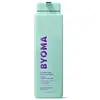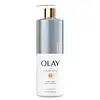What's inside
What's inside
 Key Ingredients
Key Ingredients

 Benefits
Benefits

 Concerns
Concerns

 Ingredients Side-by-side
Ingredients Side-by-side

Bakuchiol
AntimicrobialWater
Skin ConditioningCaprylhydroxamic Acid
Ethylhexyl Palmitate
EmollientGlyceryl Stearate Se
EmulsifyingCetyl Alcohol
EmollientParfum
MaskingGeraniol
PerfumingLimonene
PerfumingLinalool
PerfumingAlpha-Isomethyl Ionone
PerfumingCoumarin
PerfumingGlycerin
HumectantRicinus Communis Seed Oil
MaskingSodium Hydroxide
BufferingLactic Acid
BufferingPhenoxyethanol
PreservativeBenzyl Alcohol
PerfumingDehydroacetic Acid
PreservativeSodium Benzoate
MaskingButyrospermum Parkii Butter
Skin ConditioningEthylhexylglycerin
Skin ConditioningAvena Sativa Kernel Flour
AbrasiveBeta-Glucan
Skin ConditioningCeramide NP
Skin ConditioningCholesterol
EmollientCaprylic/Capric Triglyceride
MaskingPhytosphingosine
Skin ConditioningStearic Acid
CleansingOleic Acid
EmollientCaprylyl Glycol
EmollientAllantoin
Skin Conditioning1,2-Hexanediol
Skin ConditioningHydrogenated Lecithin
EmulsifyingCarbomer
Emulsion StabilisingBakuchiol, Water, Caprylhydroxamic Acid, Ethylhexyl Palmitate, Glyceryl Stearate Se, Cetyl Alcohol, Parfum, Geraniol, Limonene, Linalool, Alpha-Isomethyl Ionone, Coumarin, Glycerin, Ricinus Communis Seed Oil, Sodium Hydroxide, Lactic Acid, Phenoxyethanol, Benzyl Alcohol, Dehydroacetic Acid, Sodium Benzoate, Butyrospermum Parkii Butter, Ethylhexylglycerin, Avena Sativa Kernel Flour, Beta-Glucan, Ceramide NP, Cholesterol, Caprylic/Capric Triglyceride, Phytosphingosine, Stearic Acid, Oleic Acid, Caprylyl Glycol, Allantoin, 1,2-Hexanediol, Hydrogenated Lecithin, Carbomer
Water
Skin ConditioningGlycerin
HumectantNiacinamide
SmoothingPetrolatum
EmollientIsopropyl Isostearate
EmollientCaprylic/Capric Triglyceride
MaskingPanthenol
Skin ConditioningTocopheryl Acetate
AntioxidantPalmitoyl Pentapeptide-4
Skin ConditioningTapioca Starch
Dimethicone
EmollientStearyl Alcohol
EmollientPhenoxyethanol
PreservativeCetyl Alcohol
EmollientSodium Acrylates Copolymer
Benzyl Alcohol
PerfumingParfum
MaskingBehenyl Alcohol
EmollientDimethiconol
EmollientPEG-100 Stearate
Cetearyl Glucoside
EmulsifyingCetearyl Alcohol
EmollientDisodium EDTA
Ethylhexylglycerin
Skin ConditioningStearic Acid
CleansingPalmitic Acid
EmollientPolymethylsilsesquioxane
Sodium Hydroxide
BufferingCI 19140
Cosmetic ColorantCI 17200
Cosmetic ColorantWater, Glycerin, Niacinamide, Petrolatum, Isopropyl Isostearate, Caprylic/Capric Triglyceride, Panthenol, Tocopheryl Acetate, Palmitoyl Pentapeptide-4, Tapioca Starch, Dimethicone, Stearyl Alcohol, Phenoxyethanol, Cetyl Alcohol, Sodium Acrylates Copolymer, Benzyl Alcohol, Parfum, Behenyl Alcohol, Dimethiconol, PEG-100 Stearate, Cetearyl Glucoside, Cetearyl Alcohol, Disodium EDTA, Ethylhexylglycerin, Stearic Acid, Palmitic Acid, Polymethylsilsesquioxane, Sodium Hydroxide, CI 19140, CI 17200
 Reviews
Reviews

Ingredients Explained
These ingredients are found in both products.
Ingredients higher up in an ingredient list are typically present in a larger amount.
Benzyl Alcohol is most commonly used as a preservative. It also has a subtle, sweet smell. Small amounts of Benzyl Alcohol is not irritating and safe to use in skincare products. Most Benzyl Alcohol is derived from fruits such as apricots.
Benzyl Alcohol has both antibacterial and antioxidant properties. These properties help lengthen the shelf life of products. Benzyl Alcohol is a solvent and helps dissolve other ingredients. It can also improve the texture and spreadability.
Alcohol comes in many different forms. Different types of alcohol will have different effects on skin. This ingredient is an astringent alcohol.
Using high concentrations of these alcohols are drying on the skin. They may strip away your skin's natural oils and even damage your skin barrier. Astringent alcohols may also irritate skin.
Other types of astringent alcohols include:
According to the National Rosacea Society based in the US, you should be mindful of products with these alcohols in the top half of ingredients.
Any type of sanitizing product will have high amounts of alcohol to help kill bacteria and viruses.
Learn more about Benzyl AlcoholThis ingredient is an emollient, solvent, and texture enhancer. It is considered a skin-softener by helping the skin prevent moisture loss.
It helps thicken a product's formula and makes it easier to spread by dissolving clumping compounds.
Caprylic Triglyceride is made by combining glycerin with coconut oil, forming a clear liquid.
While there is an assumption Caprylic Triglyceride can clog pores due to it being derived from coconut oil, there is no research supporting this.
Learn more about Caprylic/Capric TriglycerideCetyl Alcohol is a fatty alcohol. Fatty Alcohols are most often used as an emollient or to thicken a product.
Its main roles are:
Though it has "alcohol" in the name, it is not related to denatured alcohol or ethyl alcohol.
The FDA allows products labeled "alcohol-free" to have fatty alcohols.
Learn more about Cetyl AlcoholEthylhexylglycerin (we can't pronounce this either) is commonly used as a preservative and skin softener. It is derived from glyceryl.
You might see Ethylhexylglycerin often paired with other preservatives such as phenoxyethanol. Ethylhexylglycerin has been found to increase the effectiveness of these other preservatives.
Glycerin is already naturally found in your skin. It helps moisturize and protect your skin.
A study from 2016 found glycerin to be more effective as a humectant than AHAs and hyaluronic acid.
As a humectant, it helps the skin stay hydrated by pulling moisture to your skin. The low molecular weight of glycerin allows it to pull moisture into the deeper layers of your skin.
Hydrated skin improves your skin barrier; Your skin barrier helps protect against irritants and bacteria.
Glycerin has also been found to have antimicrobial and antiviral properties. Due to these properties, glycerin is often used in wound and burn treatments.
In cosmetics, glycerin is usually derived from plants such as soybean or palm. However, it can also be sourced from animals, such as tallow or animal fat.
This ingredient is organic, colorless, odorless, and non-toxic.
Glycerin is the name for this ingredient in American English. British English uses Glycerol/Glycerine.
Learn more about GlycerinParfum is a catch-all term for an ingredient or more that is used to give a scent to products.
Also called "fragrance", this ingredient can be a blend of hundreds of chemicals or plant oils. This means every product with "fragrance" or "parfum" in the ingredients list is a different mixture.
For instance, Habanolide is a proprietary trade name for a specific aroma chemical. When used as a fragrance ingredient in cosmetics, most aroma chemicals fall under the broad labeling category of “FRAGRANCE” or “PARFUM” according to EU and US regulations.
The term 'parfum' or 'fragrance' is not regulated in many countries. In many cases, it is up to the brand to define this term.
For instance, many brands choose to label themselves as "fragrance-free" because they are not using synthetic fragrances. However, their products may still contain ingredients such as essential oils that are considered a fragrance by INCI standards.
One example is Calendula flower extract. Calendula is an essential oil that still imparts a scent or 'fragrance'.
Depending on the blend, the ingredients in the mixture can cause allergies and sensitivities on the skin. Some ingredients that are known EU allergens include linalool and citronellol.
Parfum can also be used to mask or cover an unpleasant scent.
The bottom line is: not all fragrances/parfum/ingredients are created equally. If you are worried about fragrances, we recommend taking a closer look at an ingredient. And of course, we always recommend speaking with a professional.
Learn more about ParfumPhenoxyethanol is a preservative that has germicide, antimicrobial, and aromatic properties. Studies show that phenoxyethanol can prevent microbial growth. By itself, it has a scent that is similar to that of a rose.
It's often used in formulations along with Caprylyl Glycol to preserve the shelf life of products.
Sodium Hydroxide is also known as lye or caustic soda. It is used to adjust the pH of products; many ingredients require a specific pH to be effective.
In small amounts, sodium hydroxide is considered safe to use. However, large amounts may cause chemical burns due to its high alkaline.
Your skin has a natural pH and acid mantle. This acid mantle helps prevent harmful bacteria from breaking through. The acid mantle also helps keep your skin hydrated.
"Alkaline" refers to a high pH level. A low pH level would be considered acidic.
Learn more about Sodium HydroxideStearic Acid is a fatty acid. It is an emollient, emulsifier, and texture enhancer.
As an emollient, stearic acid helps soften skin. It aids the skin's protective barrier by preventing water loss. It also provides a gentle cleansing effect without stripping away natural oils.
Stearic acid may also be used to enhance the texture of products. It can add volume and stabilize ingredients such as water and oil. This can help water and oil ingredients from separating.
Sources of stearic acid include animal or vegetable fats/oils such as coconut or shea. It can be naturally found in butter, cocoa butter, shea butter, vegetable fats, and animal tallow.
This ingredient may not be Malassezia folliculitis, or fungal-acne safe.
Learn more about Stearic AcidWater. It's the most common cosmetic ingredient of all. You'll usually see it at the top of ingredient lists, meaning that it makes up the largest part of the product.
So why is it so popular? Water most often acts as a solvent - this means that it helps dissolve other ingredients into the formulation.
You'll also recognize water as that liquid we all need to stay alive. If you see this, drink a glass of water. Stay hydrated!
Learn more about Water